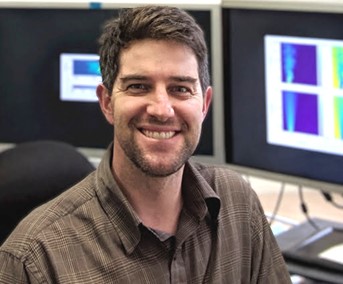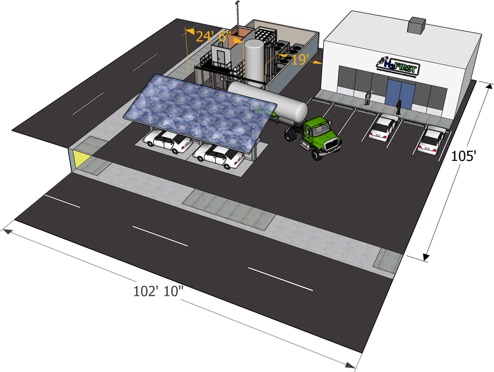Award highlights research advancing the safe deployment of hydrogen technologies

Drivers might not always ponder the safety features that surround them as they cruise into their local gas stations for a fill-up. But for Sandia researcher Ethan Hecht, the design and safety of fueling stations have been the focus of several years of experiments and research.
The goal is to ensure hydrogen can be used safely and easily at fueling stations where hydrogen-powered vehicles can refill their tanks, much like their gasoline-powered counterparts.
Specifically, Ethan’s work has centered on the National Fire Protection Association’s Hydrogen Technologies Code, known as NFPA 2. Ethan and his collaborators have investigated prescribed setback distances for storing liquid hydrogen in bulk — distances that dictate how far storage tanks must be from other infrastructure.
For this work, DOE’s Hydrogen and Fuel Cell Technologies Office presented Ethan with an award for technology acceleration during its annual merit review in June.
The award highlights how Ethan’s work to promote hydrogen safety and minimize risk has enabled a decrease in the footprint and cost of hydrogen fueling stations. His research was noted for “facilitating the advancement of hydrogen and fuel cell technologies and laying the framework for the safe deployment of hydrogen technologies at scale.”
“Our hydrogen team focuses on the scientific basis for codes and standards. We use hydrogen flow models, experimental validation and risk assessments to establish an understanding of hydrogen behavior. Ethan’s experiments are critical to this understanding,” said Kristin Hertz, Sandia’s hydrogen program manager. “To enable this result, Ethan had to develop instrumentation and diagnostics to remotely sense hydrogen concentrations in the lab as well as outdoors. His laser-based diagnostic is a first-of-its-kind capability.”

NFPA 2 is a fire code that provides requirements and guidelines for many types of hydrogen systems. Among other recommendations and requirements, the code dictates how fueling stations handle and store hydrogen. According to a report written by Ethan and his colleagues, “One key barrier to the deployment of fueling stations is the land area they require (i.e., their “footprint”). Space is particularly a constraint in dense urban areas where hydrogen demand is high but space for fueling stations is limited.” By helping to characterize cryogenic hydrogen plumes, Ethan’s experiments supported revised safety standards and setback distances for liquid hydrogen storage.
“It’s thrilling to see this work recognized, especially because the improved understanding and modeling of hydrogen behavior have led to the first update to liquid hydrogen separation distances since their inception half a century ago,” Ethan said. “I want to thank the entire hydrogen safety community — who are all collaboratively working hard to enable this carbon-free energy carrier — particularly the team at Sandia, both current and past. This includes postdoctoral researchers Pratikash Panda and Bikram Roy Chowdhury, who were instrumental in developing the diagnostics we are using for liquid hydrogen experiments.”
Hydrogen fueling stations have the potential to support a more widespread use of fuel cell electric vehicles. During the annual merit review’s plenary session, Secretary of Energy Jennifer Granholm addressed the larger role of the research presented at the review: “Those of you who joined us for the 2021 review might recall us in fact saying that hydrogen has the potential to be perhaps the most important clean-energy innovation in the world. And getting this right is going to mean unlocking a source of clean, dispatchable power and really a new method of energy storage.”
This work is funded by the DOE Hydrogen & Fuel Cell Technologies Office in the Office of Energy Efficiency and Renewable Energy. The Safety Codes and Standards subprogram has funded research by Sandia since 2003 to provide data and analyses to support science-based regulations, codes and standards for hydrogen and fuel cell technologies.